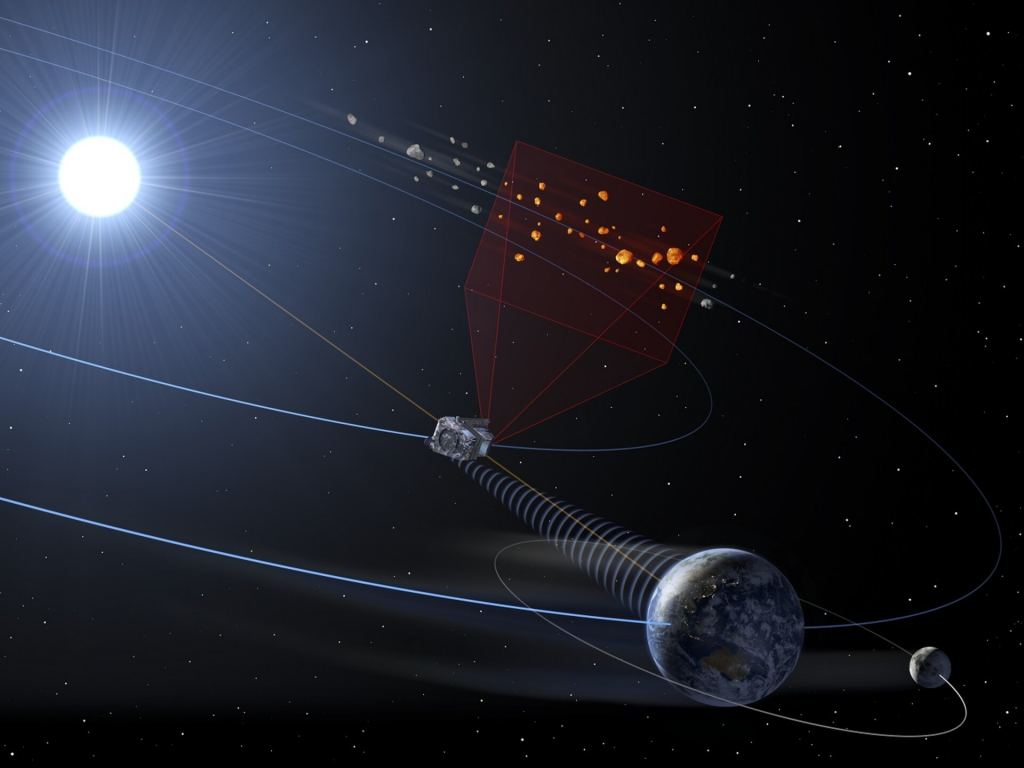The European Space Agency is working on a new mission that would act as an early warning system for dangerous, hard-to-see asteroids. Called NEOMIR (Near-Earth Object Mission in the InfraRed) , the spacecraft would orbit between the Earth and the Sun at the L1 Lagrange Point, finding space rocks that otherwise get lost in the glare of the Sun. Usually, astronomers can discover asteroids thanks to the light they reflect from the Sun.
The proposed NEOMIR mission would have the ability to find asteroids 20 meters and larger that can’t be seen from the ground, ones that are heading towards Earth and coming from the direction of the Sun. These could be imminent impactors, on a collision course with Earth. The spacecraft would use a half-meter telescope with a large, corrected focal plane with the ability to see in infrared light in the 5-10 micrometer waveband.
Remove All Ads on Universe Today Join our Patreon for as little as $3! Get the ad-free experience for life ESA says that NEOMIR will monitor a close ring around the Sun, a region that is impossible to observe from telescopes on Earth because of the Sun’s blinding glare. By making observations in the infrared part of the light spectrum, NEOMIR will detect the heat emitted by asteroids themselves, which isn’t drowned out by sunlight. Additionally, this particular range of thermal emissions are absorbed by Earth’s atmosphere – another reason why an Earth-based telescope wouldn’t fit the bill.
Also, as a space-based observatory, NEOMIR will be able to see closer to the Sun than we can currently see from the ground. Asteroids in that region that are 20 meters and larger and heading toward Earth should be detected by NEOMIR at least three weeks in advance. In the worst-case scenario, in which the asteroid is spotted passing near the spacecraft, we would get a minimum of three days’ warning – the fastest the asteroid could move from L1 to Earth.
NEOMIR is currently early mission study phase. If all goes well, it will be launched in 2030 on an Ariane 6-2 rocket. It could work in tandem with NASA’s NEO Surveyor mission, providing us even more warning of a deadly asteroid.
NEO Surveyor is set to launch in 2026 and it should fulfil the US Congress mandate to discover 90% of near-Earth objects larger than 140-meters in diameter. An asteroid similar to the Chelyabinsk meteor – which caused an airburst event as it broke up in Earth’s atmosphere above the city of Chelyabinsk in Russia – is the type of space rock NEOMIR could detect. That meteor’s radiant, or source direction, was close to the Sun and it came in undetected by other observatories.
However, its size would be right on the cusp of the size that NEOMIR could detect. That space rock was approximately 18 m (59 ft) in diameter and weighed 9,100-tonnes (10,000-short-tons). The shockwave caused by the airburst blew out windows and damaged buildings, injuring nearly 1,500 people.
About 7,200 buildings in six cities across the region were damaged. Larger space rocks could cause even more damage and destruction if any were to strike Earth. However, their estimated population in our Solar System is estimated to be rather small and more than 90% of these are thought to have been discovered.
None of these that are known pose any risk of impact. Only a tiny fraction of the estimated population of small asteroids ? below 10 m diameter ? have been discovered, but they would break up on the atmosphere, like the and any impact would be harmless. Related: Another Meteoroid Discovered Right Before It Hits Earth’s Atmosphere.
But it is the population of asteroids that are basically invisible that cause astronomers to lose sleep at night. NEOMIR will help to find those hidden asteroids. An initial study to assess the feasibility of the NEOMIR mission was conducted by ESA’s Concurrent Design Facility in the Netherlands, in 2021, and the design is currently being fleshed out, with detector technologies and associated electronics for this novel mission currently under development.
.
From: universetoday
URL: https://www.universetoday.com/160181/esa-is-building-an-early-warning-system-for-dangerous-asteroids/



